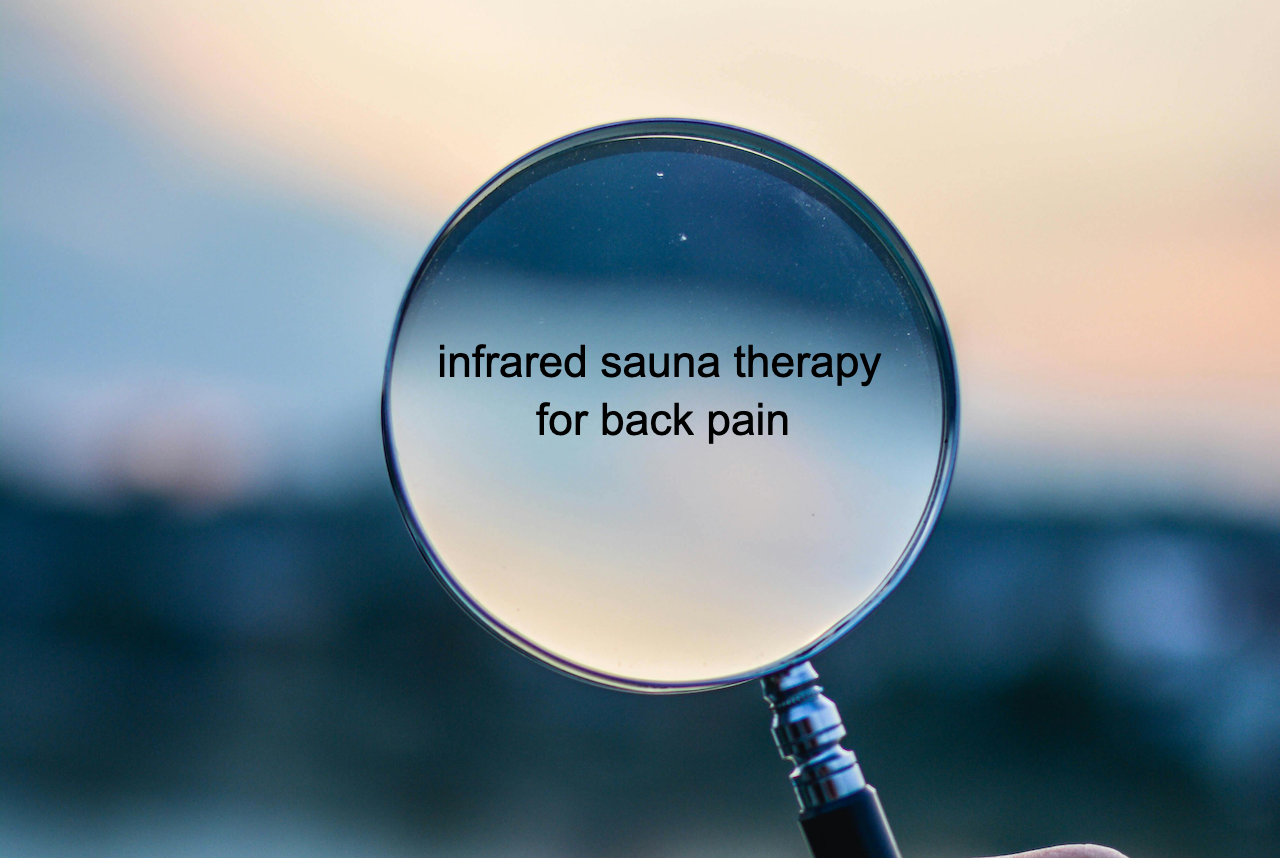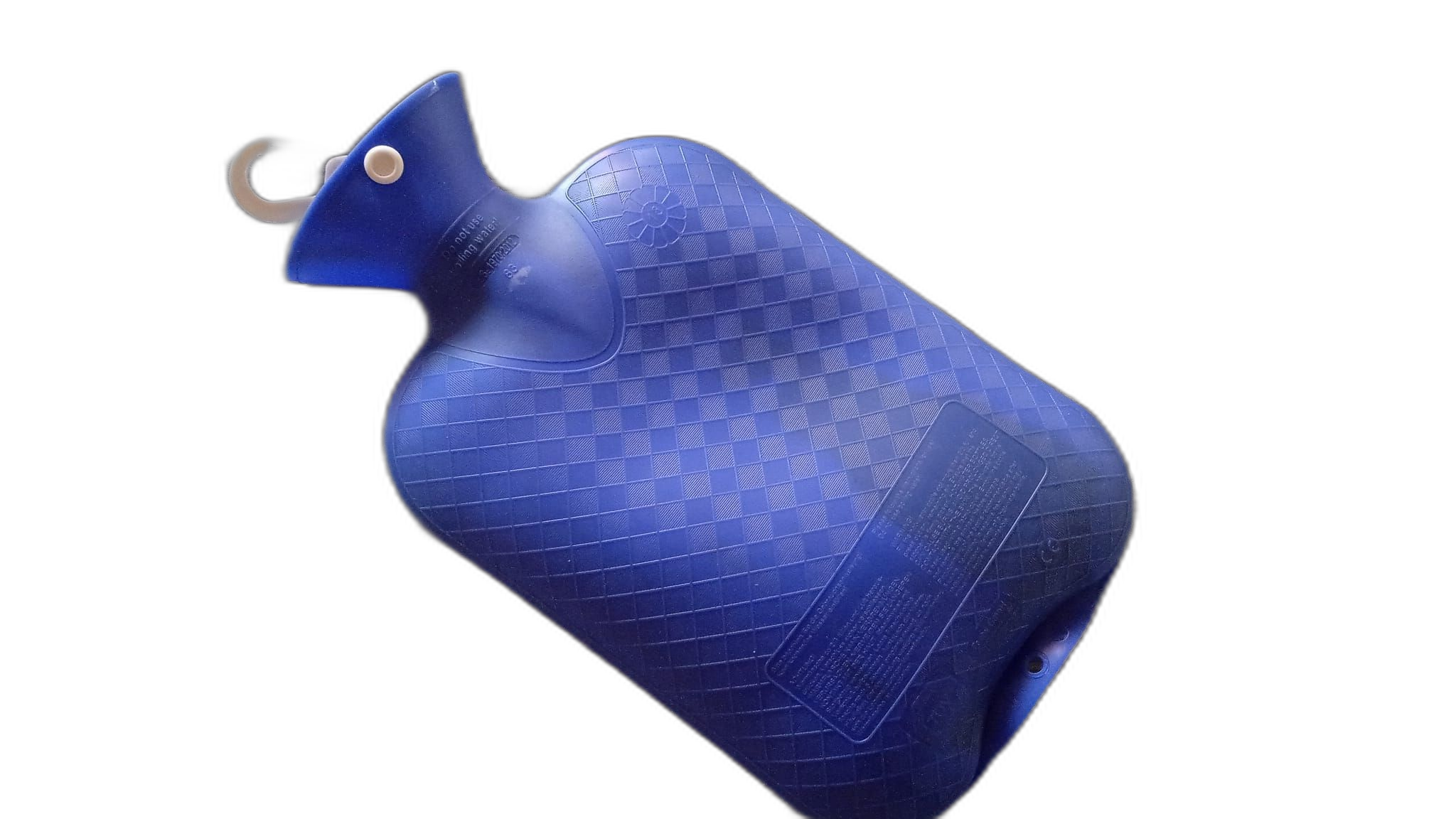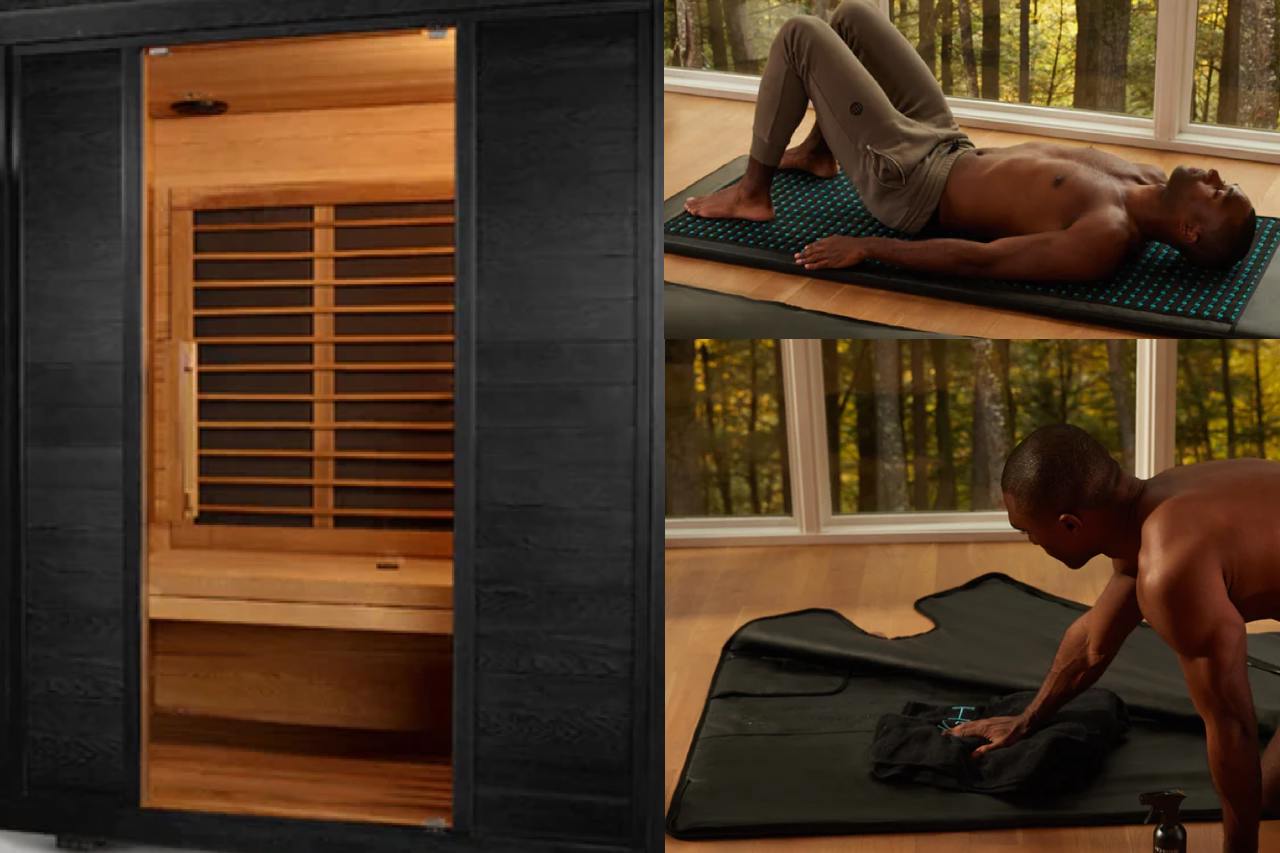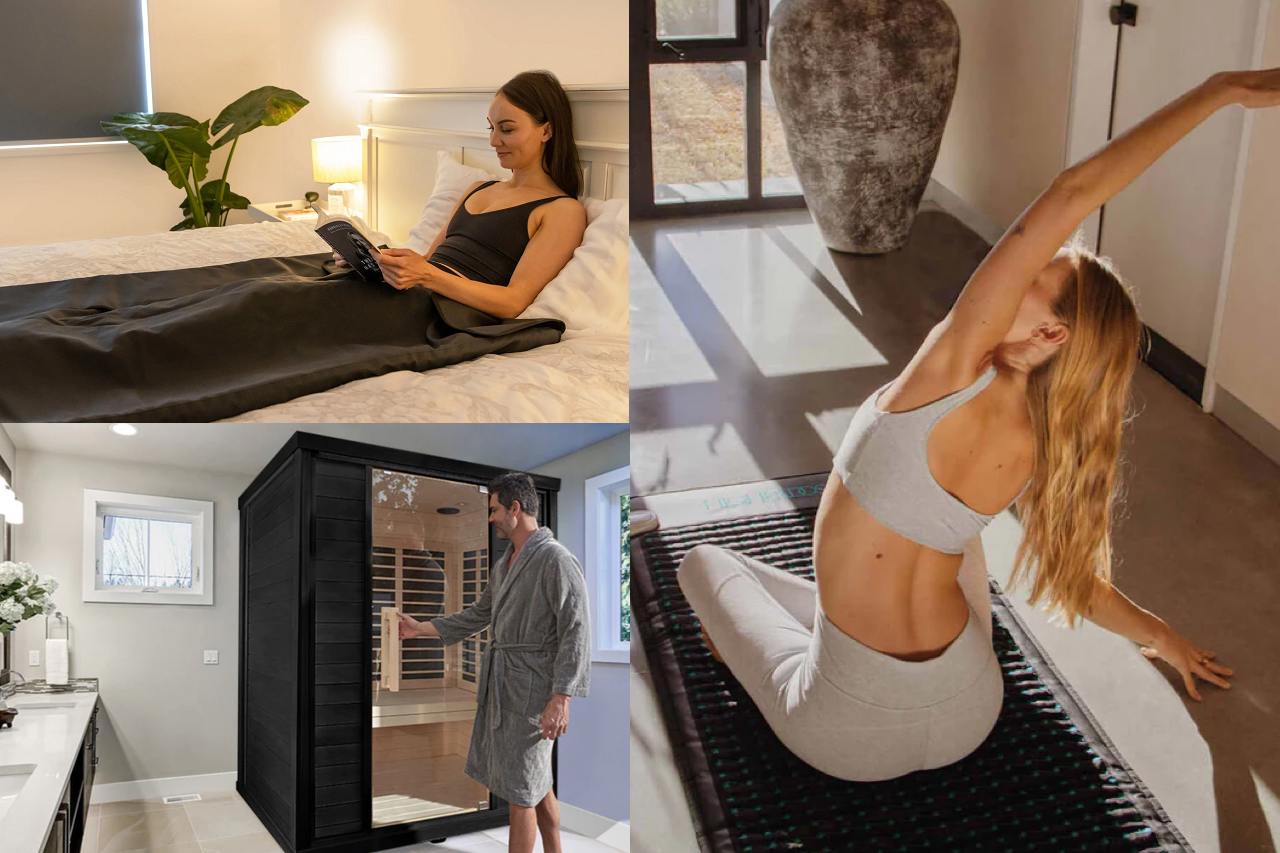- HOME
- Infrared Sauna Benefits
- Back Pain
How Does
Infrared Sauna Help Back Pain?

Struggling with back pain? You're part of a vast majority. Eight out of ten people do experience the sting of back pain somewhere in their lives, and traditional remedies often fall short [1]. There's a potential ally in this battle that you may not have tried yet: infrared saunas.
An infrared sauna is designed to reduce inflammation, improve circulation, and provide a deeper form of relief that many find essential for managing back pain. Infrared solutions come in all sorts of forms, from blankets, to cabins and even mats for your chair.
But let's take it one step further and see if the warmth of an infrared sauna might be the step you need towards a more comfortable life. Sometimes the best solutions are the ones we least expect.
A quick tour of the blog post
- Backpain: Causes, types and impact
- Backpain treatments
- Infrared sauna for back pain relief
- Research
- What infrared sauna to choose?
Understanding Back Pain: Causes, Types, and Impact
The Roots of Back Pain
Back pain affects people of all ages, from adolescents to the elderly [2]. The condition has a major impact on daily life, limits activities and reduces the quality of life for many people.
Its causes are as varied as its consequences.
To effectively tackle back pain, it is important to look at its cause. Back pain is often the result of a combination of causes, such as:
- Lifestyle choices, like excessive sitting and/or lack of exercise
- Stress
- Work-related tensions
- Age-related wear
These factors can all lead to back tension and pain. In addition, they can also contribute to inflammation and poor circulation, turning temporary discomfort into chronic conditions.
Back pain can also stem from specific medical conditions, such as arthritis or spinal disorders.

The Many Faces of Back Pain
The following types of back pain are common:
- Chronic Lower Back Pain: The most frequent type, lasting over three months, often due to previous injuries, arthritis, or sometimes unknown reasons.
- Muscle or Ligament Strain: Typically results from heavy lifting or awkward movements, characterized by muscle spasms and movement-aggravated pain.
- Bulging or Herniated Discs: When spine-cushioning discs protrude or tear, pressing on nerves.
- Degenerative Disc Disease: Age-related spinal disc changes can lead to pain, instability, and reduced flexibility.
- Spondylolisthesis: A vertebra slipping over another, usually from a spinal stress fracture.
- Spinal Stenosis: The spinal column narrows, pressing on the spinal cord and nerves.
- Sciatica: Triggered by sciatic nerve irritation or compression, extending from the lower back down the legs.
- Osteoarthritis: This degenerative joint disease affects the lower back, causing pain, swelling, and limited spinal motion.
Back pain: A Snapshot of Its Impact
Back pain is more than just an ache—it's a significant health concern. Here are some fast facts that underscore its prevalence [3]:
- 80% of people will encounter back pain at some point.
- It's most prevalent among adults aged 35 to 55.
- Women are more prone to lower back pain than men, potentially due to factors like hormones, pregnancy, and muscle mass.
- Over half of working Americans report back pain symptoms each year.
- Back pain is responsible for over 264 million lost workdays annually—that's about two days for every full-time worker.
- Direct healthcare costs for back pain exceed $50 billion each year in the U.S., with lost wages and decreased productivity driving indirect costs even higher.
- It is the leading cause of disability across the globe.

Back pain treatments
Acute back pain
Often the result of minor injuries or muscle strains. Usually resolves with self-care. The focus of the treatment is on rest, applying heat or cold compresses and, if necessary, supplemented with painkillers (ibuprofen/paracetamol).
Chronic back pain
When the pain lasts for months or returns frequently, stronger treatments such as muscle relaxants, painkillers or analgesic injections are common. In addition, physiotherapy is often used for muscle strengthening exercises. In addition, heat therapy, ultrasound or electrical stimulation can be applied. Surgery is considered a last resort
Complementary treatments
When traditional treatments fall short, many turn to alternative therapies for back pain relief, such as chiropractic care, acupuncture, biofeedback, transcutaneous electrical nerve stimulation (TENS), or relaxation therapies (massages, yoga, mindfulness).

Self-Care practices
Self-care plays an important role in the treatment of back pain. [4]
Lifestyle Adjustments
Advice focused on long-term habits and environmental changes to support spinal health and prevent back pain:
- Maintaining proper posture
- Setting up an ergonomic workspace
- Mindful lifting techniques
- Stress management
- Maintaining a healthy weight
- Quitting smoking
- Back-friendly sleeping position
Active Pain Management Techniques
To immediately relieve back pain and promote recovery, the following actions are recommended (in addition to medication):
- Rest
- Being active in daily routines and low-impact exercises (such as walking)
- Heat and ice therapy
Heat therapy, possibly alternated with cold therapy, is therefore even recommended when it comes to home care for back pain. What happens when you use infrared sauna therapy as an alternative way to address your back pain?

A DEEP HEAT APPROACH TO RELIEF BACK PAIN
Infrared saunas use infrared wavelengths to penetrate deep into your skin, directly heating your body, unlike traditional dry and steam saunas, which warm you by heating the air around you.
IR saunas operate at lower temperatures compared to conventional saunas. This can make the sauna experience more comfortable and can't tolerate the high temperatures of traditional saunas.
The deep, therapeutic heat of infrared saunas targets the root causes and symptoms in a multileveled way:
Reduce Inflammation
Due to daily habits or underlying conditions, persistent inflammation can worsen pain. To alleviate back pain, you need to treat the underlying inflammation. The profoundly infiltrating rays of the sauna directly reach the inflamed back muscles and tissues.
Detoxification
The buildup of toxins in the body can contribute to inflammation and stress, further worsening back pain. Infrared saunas stimulate sweating at a deep level and aid in the effective detoxification of the body.
Improved Blood Flow
For back problems, it helps to improve the blood supply for more reasons (to, among other things, the muscles of your back). After all, when circulation is compromised, what was a minor muscle strain can lead to an escalation of persistent discomfort.
Infrared saunas use their gentle heat to dilate blood vessels and improve circulation throughout the body. This results in:
- Better blood flow clears the path, effectively flushing out toxins and making room to heal. By directly addressing the circulatory bottlenecks that often underlie back pain, infrared saunas facilitate a smooth recovery process.
- Boosting circulation amplifies the efficient supply of essential nutrients to the affected areas. The healing process speeds up, and so gives relief from one of the main causes of back problems.
Stress Relief
The burdens of stress and tension cast a notable shadow on our physical well-being, manifesting themselves especially in our backs. Knots and spasms occur that grip our spinal and back muscles like a vice.
The comfortable heat and environment of an infrared sauna provides a mini spa experience that promotes deep relaxation and stress relief. The infrared sauna not only reduces muscle tension but also lowers cortisol levels, the stress hormone. In this way they tackle the cause of stress-related back pain.
Infrared saunas hold great promise for the relief of back pain. But what does scientific research say about this therapy in relation to back pain?

Research
During our exploration of research on infrared therapy, we came across an interesting study (2012) that compared infrared sauna with hot packs, another form of heat therapy that is often used at home.
Infrared vs. Hot Pack: Efficacy
The study [5] compared the effectiveness of infrared therapy and hot pack treatments in relieving the pain resulting from lumbar disc herniation – a common cause of lower back pain that affects up to 90% of the population at some point in their lives.

This study included 60 patients diagnosed with hernia, who were randomly assigned to the infrared therapy group or the hot pack treatment group. The interventions were carried out three times a week for a period of one month, with the severity and duration of pain before and after the treatments measured with a numerical rating scale.
The findings showed that both infrared and hot pack treatments substantially diminished the severity of pain, with infrared therapy showing a clear benefit in shortening the duration of pain.
Dry Sauna Therapy's Impact on Low Back Pain
The results of this 2019 study [6] revealed the potential of dry sauna therapy in the treatment of lower back pain. Participants experienced less pain and a revitalization in quality of life. It was also noted by the researchers that there were no adverse effects associated with the sauna sessions.
Although infrared saunas are not dry saunas, they do work according to the same mechanism of heat therapy. This suggests that infrared sauna could provide similar positive, if not improved, benefits for individuals suffering from lower back pain.

Discover the various options for your infrared sauna at home: from cabins to blankets
Infrared Therapy for Chronic Low Back Pain
In a (2006) study on chronic low back pain [7], 40 participants were divided into two groups: one received targeted infrared (IR) therapy via portable units, while the other got placebo treatments with inactive units.
After seven weeks, those with real IR therapy reported a marked pain decrease, with average scores dropping from 6.9 to 3 out of 10, compared to a modest effect in the placebo group.
Although this method differs from the ambient heat of IR saunas, the positive results suggest that IR saunas could similarly benefit back pain sufferers by improving circulation and reducing inflammation, offering a promising, safe, and effective treatment alternative.
Infrared Therapy for Musculoskeletal and Chronic Pain
This 2022 review [8] includes an analysis of various studies into pain relief with infrared therapy in patients with conditions such as osteoarthritis, fibromyalgia and chronic low back pain.
Based on the data, the researchers concluded that the deep reach of the IR wavelengths resulted in pain relief, less muscle stiffness and lower inflammation levels.
The findings of the discussed studies suggest that infrared sauna therapy promises opportunities for the treatment of back pain.
The application of infrared technology offers a non-invasive, complementary approach to traditional pain management strategies. This is in line with a growing interest in alternative therapies. In addition, the ability to use it at home in your self care routine is a big plus.
But before you decide to use infrared sauna therapy, it is advisable to consult your doctor, especially if you have any specific health conditions or concerns.

Find Your Perfect Infrared Sauna Companion
Do you no longer want to let back pain rule your days and use the power of infrared saunas as a complementary recovery and pain management strategy? Then the search for the perfect infrared sauna for your home has started.
We, at Saunace.com, know that the range of infrared options such as blankets, cabins, tents, mats can feel a bit overwhelming. Let us guide you through the maze of options with unbiased, expert advice tailored to your lifestyle, space, and preferences.
Discover the ideal infrared sauna that not only meets your back pain relief needs but also complements your life in every way.
Whether you're constantly on the move, obtain a minimalist lifestyle, live in an urban apartment, or dream of shared wellness experiences with loved ones, there's an infrared sauna solution tailored just for you.
Considering the importance of rest and good positioning in managing back pain, we advocate solutions that allow you to fully relax in a lying position:

Find your perfect infrared sauna companion at saunace.com
Infrared Sauna Blankets
You don't need a large sauna to experience the health benefits of an infrared sauna. This blanket is ideal if you are looking for a personal, intimate environment. They are affordable, easy to clean, carry and store.
IR Sauna Cabins
On the other hand, spacious infrared sauna cabins are not just about physical size, but also about the freedom they offer. Within the wooden walls of the sauna cabin there is not only enough space to lie comfortably.
There is also space to stretch, move and even incorporate gentle exercises or yoga postures, which further contributes to improving blood flow and flexibility. The room also invites you to share sauna sessions with partners, family, or friends.
Infrared PEMF Mats
In addition to infrared therapy, PEMF mats provide Pulsed Electromagnetic Field Therapy, a new approach to pain relief (PEMF for pain). They promote healing and reduce inflammation. Some mats even come with pads for TENS therapy [9].
The combination of the various therapies offers a powerful synergy for tackling back pain. The advantage of these mats is that they can often be used for longer (2-4 hours). In addition, the smaller PEMF mats offer the option of therapy while you drive or sit at your desk.
We invite you to check out our reviews of sauna blankets and PEMF mats at saunace.com.

Diane Sargent
Looking for more information? These articles might be of interest
References
1. Rubin Devon, Epidemiology and risk factors for spine pain, PubMed, https://pubmed.ncbi.nlm.nih.gov/17445733/
2. Mayo Clinic, Back Pain, https://www.mayoclinic.org/diseases-conditions/back-pain/symptoms-causes/syc-20369906
3. American Chiropractic Association (ACA), Back Pain Facts and Statistics,, https://handsdownbetter.org/health-and-wellness/back-pain-facts-and-statistics/
4. Kendall Snyder, M.D., Back pain self-care tips, Mayo Clinic, https://www.mayoclinichealthsystem.org/hometown-health/speaking-of-health/back-pain-self-care-tips
5. Mokhtar, Yaghobi et al., Comparison of the effect of infra red and hot pack on reduction of pain associated with lumbar discopathy, Global Index Medicus, https://search.bvsalud.org/gim/resource/es/emr-155324
6. Eun-Hee Cho eyt al., Dry sauna therapy is beneficial for patients with low back pain, PubMed, https://www.ncbi.nlm.nih.gov/pmc/articles/PMC7713799/
7. George D Gale, et al., Infrared therapy for chronic low back pain: A randomized, controlled trial, PubMed, https://www.ncbi.nlm.nih.gov/pmc/articles/PMC2539004/
8. Christos Tsagkaris et al., Infrared Radiation in the Management of Musculoskeletal Conditions and Chronic Pain: A Systematic Review, PubMed, https://pubmed.ncbi.nlm.nih.gov/35323210/
9. Cleveland Clinic, Transcutaneous Electrical Nerve Stimulation (TENS), https://my.clevelandclinic.org/health/treatments/15840-transcutaneous-electrical-nerve-stimulation-tens


